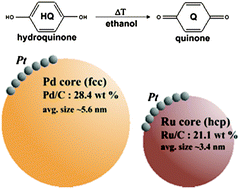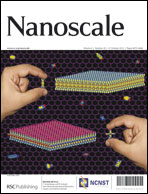We report a new method for deposition of Pt on a metal core to develop real electrocatalysts with significantly reduced amounts of expensive Pt as well as enhanced activity for oxygen reduction reaction. Ru and Pd have different crystal structures and modify the electronic structure of Pt to a different extent (shifts in d-band center). They were chosen as core materials to examine whether hydroquinone dissolved in ethanol can be used to deposit additional Pt atoms onto preformed core nanoparticles, and whether the modified d-character of Pt on different host metals can result in the enhanced ORR activity. The physicochemical characteristics of Pd–Pt and Ru–Pt core–shell nanoparticles are investigated. The core–shell structure was identified through a combination of experimental methods, employing electron microscopy, electrochemical measurements, and synchrotron X-ray measurements such as powder X-ray diffraction, X-ray absorption fine structure, and X-ray photoelectron spectroscopy. The hydroquinone reduction method proved to be an excellent route for the epitaxial growth of a Pt shell on the metal cores, leading to enhanced ORR activities.

You have access to this article
 Please wait while we load your content...
Something went wrong. Try again?
Please wait while we load your content...
Something went wrong. Try again?


 Please wait while we load your content...
Please wait while we load your content...